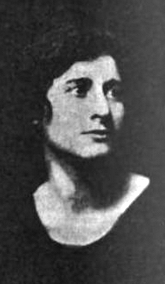Sara Mildred Strauss
Sara Mildred Strauss | |
|---|---|
 Sara Mildred Strauss from a 1918 publication. | |
| Born | September 1, 1896 New York City |
| Died | July 7, 1979 Wilmington, North Carolina |
| Nationality | American |
| Other names | S. Mildred Strauss, Sara Mildred Strauss Newman (after marriage) |
| Occupation | Dancer, choreographer, educator, writer |
Sara Mildred Strauss (September 1, 1896 – July 7, 1979) was an American dancer, educator, choreographer, and writer.
Early life[]
Strauss was born in 1896, in New York City, the daughter of Lehman Strauss and Pauline Cohn Strauss.[1] In 1911, she and her mother, a noted horsewoman, drove a horse-drawn carriage 280 miles, across the state of New York, as a vacation.[2]
Career[]
Dance, choreography, and dance education[]
Strauss established several dance schools, including programs at Carnegie Hall and New York's Ziegfeld Theatre, summer schools in Europe, and a studio in Hollywood.[3] She taught at the American Academy of Dramatic Arts in New York.[4] She was a friend to Russian filmmaker Sergei Eisenstein in New York.[5]
With her company, the Sara Mildred Strauss Dancers,[6] she gave a "novel and experimental" non-musical performance at New York's Guild Theatre in 1928.[7] In 1930, she fought New York's Sunday observance law, which prevented dance performances on Sundays. She argued that her company's performances were not like theatre; "without the aid of music, pantomime, decor, costume or lighting", they were more like displays of visual art.[8] In 1933 she held free public symposia on dance at her studio in Carnegie Hall, with invited speakers and informal themes.[9]
Strauss created and directed choreography for her company, who appeared in Broadway shows,[10] including the Ziegfeld Follies (1934), and Calling All Stars (1934),[11] and in the musical film Sweet Surrender (1935).[12] She also developed "Living Movement Figure Dolls", bendable mannequins for use in store windows and dance instruction.[4][13]
Writing and other activities[]
As a young woman, Strauss wrote The Dance and Life (1916), her treatise on the centrality of dance to physical and mental well-being. "The ground of all human art is bodily motion," she explained. "Into bodily motion enters rhythm, which is the mind of the dance and the skeleton of tone."[14] Here an Inch, There an Inch (1966) was her later book on similar themes.[15] She also gave advice on health, fitness, and posture in newspaper columns.[16]
In the 1920s, Strauss was active in junior auxiliary of the New York section of the National Council of Jewish Women.[17]
Personal life[]
Sara Mildred Strauss married lawyer Isaac Bear Newman (1901-1981). She moved to Wilmington, North Carolina, late in life, and died there in 1979, aged 82 years.[18] Her papers are in the Jerome Robbins Dance Collection at the New York Public Library.[4] There is another collection of her papers at the William Madison Randall Library, University of North Carolina at Wilmington.[18]
References[]
- ^ "Home Matters". The Burlington Free Press. 1905-08-22. p. 10. Retrieved 2020-04-01 – via Newspapers.com.
- ^ "Mother and Daughter Drive 280 Miles for Pleasure". The Frederick Post. 1911-09-20. p. 2. Retrieved 2020-04-01 – via Newspapers.com.
- ^ "Sara Strauss Influenced by La Duncan". The Los Angeles Times. 1936-10-25. p. 59. Retrieved 2020-04-01 – via Newspapers.com.
- ^ Jump up to: a b c Dimitriadou-Shuster, Aikaterini. "Sara Mildred Strauss papers". Jerome Robbins Dance Division, The New York Public Library for the Performing Arts. Retrieved 2020-04-01.
- ^ Seton, Marie (1960). Sergei M. Eisenstein : a biography. Niles Essanay Silent Film Museum. Grove Press. pp. 242–243.
- ^ "Stars in New Dance Technique". St. Louis Globe-Democrat. 1937-12-26. p. 67. Retrieved 2020-04-01 – via Newspapers.com.
- ^ "STRAUSS DANCERS GIVE NON-MUSICAL PROGRAM: Recital, First of Its Kind in America, Deals With Story of Creation". The New York Times. April 30, 1928. p. 18 – via ProQuest.
- ^ "SARA STRAUSS DANCES WITH AID OF COURT; Injunction Prevents Enforcement of Sunday Law--Nimura Also Performs". The New York Times. 1930-02-24. ISSN 0362-4331. Retrieved 2020-04-01.
- ^ Martin, John (9 April 1933). "The Dance: A Symposium; Discussions Sponsored by Miss Strauss Proving of Value". The New York Times. p. X6 – via ProQuest.
- ^ Dietz, Dan (2018-03-29). The Complete Book of 1930s Broadway Musicals. Rowman & Littlefield. pp. 305–306, 353–354. ISBN 978-1-5381-0277-0.
- ^ "The Stage: Shubert Theatre, 'Calling All Stars'". The Boston Globe. 1934-11-22. p. 23. Retrieved 2020-04-01 – via Newspapers.com.
- ^ Koszarski, Richard (2008-08-27). Hollywood on the Hudson: Film and Television in New York from Griffith to Sarnoff. Rutgers University Press. p. 279. ISBN 978-0-8135-4552-3.
- ^ "Where Big Girls Play with Dolls". The San Francisco Examiner. 1943-01-31. p. 79. Retrieved 2020-04-01 – via Newspapers.com.
- ^ "Revival of the Dance will Promote Musical Appreciation". Musical America. 29: 29. December 7, 1918.
- ^ Strauss, Sara Mildred (1966). Here an inch--there an inch: instant figure beauty for the modern woman. Prentice-Hall.
- ^ Lowman, Josephine (1951-01-01). "Why Grow Old?". Fort Worth Star-Telegram. p. 16. Retrieved 2020-04-01 – via Newspapers.com.
- ^ "Social Events". The American Hebrew. 108: 395. February 11, 1921.
- ^ Jump up to: a b "MS199 Sara Mildred Strauss Newman". William Madison Randall Library, University of North Carolina at Wilmington. Retrieved 2020-04-01.
External links[]
- A cigarette card featuring a photograph of Sara Mildred Strauss dancing, from the Library of Congress.
- Sara Mildred Strauss at IMDb
- Sara Mildred Strauss at Find a Grave
- The "Appassionata Ballet" sequence from Sweet Surrender (1935), with the Sara Mildred Strauss Dancers, on YouTube.
- 1896 births
- 1979 deaths
- American dancers
- American choreographers
- Jewish American writers
- Jewish dancers
- 20th-century American women writers